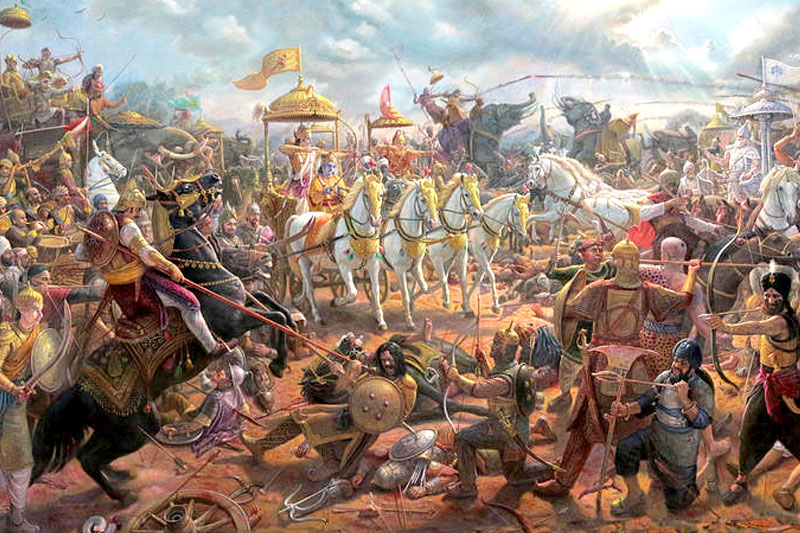
“He who imagines this [the embodied Self] the slayer and he who imagines this [the embodied Self] the slain, neither of them understands. This [the embodied Self] does not slay, nor is it slain” (Bhagavad Gita 2:19).
Except for the most unfortunately wounded in spirit, everyone is more than willing to accept the truth of their immortality. Because the authority of the Supreme Spirit is behind each word of Krishna’s exhortation to Arjuna, something deep within us responds with recognition to each statement, and that includes his insistence on the eternal nature of every spirit. Consequently there is no need for me to keep going over and over regarding that principle.
The body may appear to be killed, but never is the Self (atman) slain. This does not mean that those who (seemingly) kill others are not culpable, for it is their murderous intention that is the root evil. Having learned this in India, Jesus insisted on its truth in his teachings.
“Ye have heard that it was said by them of old time, Thou shalt not kill; and whosoever shall kill shall be in danger of the judgment: but I say unto you, That whosoever is angry with his brother without a cause shall be in danger of the judgment…Ye have heard that it was said by them of old time, Thou shalt not commit adultery: but I say unto you, That whosoever looketh on a woman to lust after her hath committed adultery with her already in his heart” (Matthew 5:21, 22, 27, 28).
He who thinks he can be killed is mistaken. This is not very hard to grasp, but the second part–the statement that the atman can no more slay than be slain–is not so commonly accepted. So it needs due consideration.
What is going on here?
Krishna has already told Arjuna that all sensory phenomena are temporary. Later he will be explaining that they are nothing more than ever-shifting movements of energy that the individual consciousness is merely observing–not undergoing, as he thinks.
Consequently the wise one watches the sense-movie and learns from it. The Mundaka Upanishad expresses it thusly: “Like two birds of golden plumage, inseparable companions, the individual self and the immortal Self are perched on the branches of the selfsame tree. The former tastes of the sweet and bitter fruits of the tree; the latter, tasting of neither, calmly observes.” In Western metaphysics the expressions “lower self” and “higher self” are often employed for these two “birds.”
The situation is this: The immortal part of us, the atman, the pure spirit (consciousness) ever looks on at the experiences of the lower self–the mind, ego, subtle and gross bodies–all that go to make up our relative “self.” But so convincing is the drama, so compelling and literally engrossing, that it loses itself in the spectacle and thinks it is born, lives, and dies over and over, feeling the pain and pleasure that are nothing more than impulses in the field of energy that is the mind. These are the vrittis in the chitta spoken of by Patanjali at the beginning of the Yoga Sutras, the permanent cessation or prevention of which is Yoga.
The movie of life
Through meditation we come to separate ourselves from the movie screen of illusion. Learning is the purpose of the movie, so we do not just throw the switch and leave the theater. Rather, we watch and figure out the meaning of everything. When we have learned the lessons, the movie will stop of itself. Yoga is the means of learning.
So we are points of consciousness tied to the seats of our bodies, helplessly watching and identifying with the 360-degree surrounding screen, overwhelmed by the sensory avalanche. When we cease to identify and come to see with the clarity of objectivity (that is the reality of the situation), then we begin to really see and learn. Then, just as the ear is trained by listening to music, so the consciousness is developed by witnessing the drama of many lives. Yet it is not changed–it is freed. For change is illusion.
When we have experienced this–and therefore truly known–for ourselves, then we know that nothing has ever “happened” to us–only to the vibrating substance which we have mistakenly thought was us. Vairagya, detachment from all things, then arises, for that is the only realistic response or view of our life. How can we have either desire or aversion toward nothing? Then perfection in true knowledge (jnana) becomes our only goal, for that perfection alone is freedom.
Further Reading:
- You Know More Than You Think You Do
- How to Deal With the Illusions of Life
- How “Wisdom” Can Get It Wrong
Grow your Spiritual Library. Get The Bhagavad Gita for Awakening.







